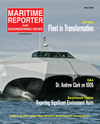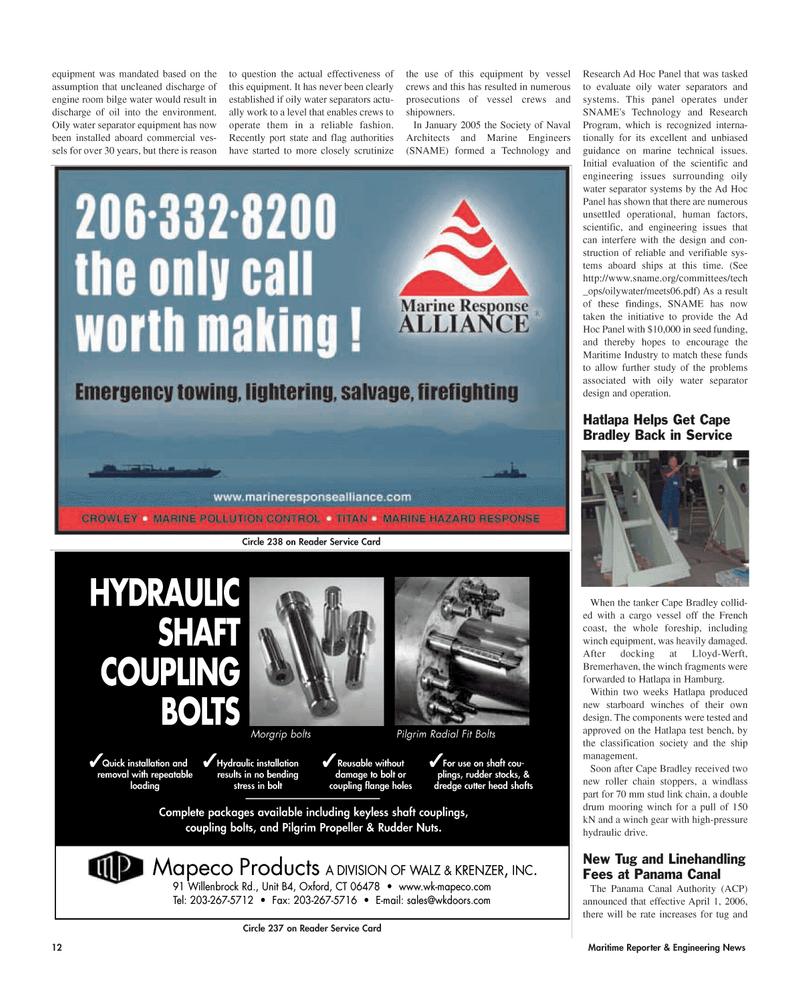
Page 12: of Maritime Reporter Magazine (March 2006)
The Training & Education Edition
Read this page in Pdf, Flash or Html5 edition of March 2006 Maritime Reporter Magazine
12 Maritime Reporter & Engineering News equipment was mandated based on the assumption that uncleaned discharge of engine room bilge water would result in discharge of oil into the environment.
Oily water separator equipment has now been installed aboard commercial ves- sels for over 30 years, but there is reason to question the actual effectiveness of this equipment. It has never been clearly established if oily water separators actu- ally work to a level that enables crews to operate them in a reliable fashion.
Recently port state and flag authorities have started to more closely scrutinize the use of this equipment by vessel crews and this has resulted in numerous prosecutions of vessel crews and shipowners.
In January 2005 the Society of Naval
Architects and Marine Engineers (SNAME) formed a Technology and
Research Ad Hoc Panel that was tasked to evaluate oily water separators and systems. This panel operates under
SNAME's Technology and Research
Program, which is recognized interna- tionally for its excellent and unbiased guidance on marine technical issues.
Initial evaluation of the scientific and engineering issues surrounding oily water separator systems by the Ad Hoc
Panel has shown that there are numerous unsettled operational, human factors, scientific, and engineering issues that can interfere with the design and con- struction of reliable and verifiable sys- tems aboard ships at this time. (See http://www.sname.org/committees/tech _ops/oilywater/meets06.pdf) As a result of these findings, SNAME has now taken the initiative to provide the Ad
Hoc Panel with $10,000 in seed funding, and thereby hopes to encourage the
Maritime Industry to match these funds to allow further study of the problems associated with oily water separator design and operation.
Hatlapa Helps Get Cape
Bradley Back in Service
When the tanker Cape Bradley collid- ed with a cargo vessel off the French coast, the whole foreship, including winch equipment, was heavily damaged.
After docking at Lloyd-Werft,
Bremerhaven, the winch fragments were forwarded to Hatlapa in Hamburg.
Within two weeks Hatlapa produced new starboard winches of their own design. The components were tested and approved on the Hatlapa test bench, by the classification society and the ship management.
Soon after Cape Bradley received two new roller chain stoppers, a windlass part for 70 mm stud link chain, a double drum mooring winch for a pull of 150 kN and a winch gear with high-pressure hydraulic drive.
New Tug and Linehandling
Fees at Panama Canal
The Panama Canal Authority (ACP) announced that effective April 1, 2006, there will be rate increases for tug and
Circle 237 on Reader Service Card
Circle 238 on Reader Service Card
Mapeco Products A DIVISION OF WALZ & KRENZER, INC. 91 Willenbrock Rd., Unit B4, Oxford, CT 06478 • www.wk-mapeco.com
Tel: 203-267-5712 • Fax: 203-267-5716 • E-mail: [email protected]
HYDRAULIC
SHAFT
COUPLING
BOLTS
Quick installation and removal with repeatable loading
Hydraulic installation results in no bending stress in bolt
Reusable without damage to bolt or coupling flange holes
For use on shaft cou- plings, rudder stocks, & dredge cutter head shafts
Morgrip bolts Pilgrim Radial Fit Bolts
Complete packages available including keyless shaft couplings, coupling bolts, and Pilgrim Propeller & Rudder Nuts. a19 a19 a19 a19
MR MARCH2006 #2 (9-16).qxd 3/2/2006 11:27 AM Page 12

 11
11

 13
13
